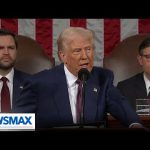President Donald Trump’s first joint address to Congress since his re-election was a fiery showcase of his administration’s priorities, blending bold claims of early accomplishments with ambitious plans for the future. Delivered under the theme of “Renewal of the American Dream,” the 100-minute speech highlighted Trump’s signature policies on immigration, trade, and government reform while also addressing pressing issues like inflation and international diplomacy. The evening was marked by both enthusiastic Republican applause and vocal Democratic protests, underscoring the deep partisan divide in Washington.
Trump opened by declaring his administration’s first 44 days a historic success, boasting that more had been achieved in this short period than most administrations accomplish in years. Central to his address was his crackdown on illegal immigration, which he described as a “slam dunk success.” He claimed that border crossings had reached record lows following his declaration of a national emergency and deployment of military forces to the southern border. While critics questioned the sustainability of these measures, Trump’s base celebrated what they saw as a decisive response to a long-standing issue.
Economic policy also took center stage, with Trump touting newly imposed 25% tariffs on imports from Canada and Mexico as a means to protect American industries. He dismissed concerns about potential price hikes, framing the tariffs as necessary to “safeguard the essence of our country.” Additionally, he unveiled plans for sweeping tax cuts targeting small businesses and middle-class families, promising relief from inflation and rising costs. However, Democrats countered that these measures would disproportionately benefit corporations and exacerbate income inequality—a point they made clear through heckling and protest signs during the speech.
Internationally, Trump addressed the contentious U.S.-Ukraine mineral deal, which has been at the heart of recent diplomatic tensions. Following a public clash with Ukrainian President Volodymyr Zelenskyy over stalled negotiations, Trump signaled optimism about finalizing an agreement that would grant the U.S. access to Ukraine’s rare earth minerals in exchange for reconstruction aid. He framed this as a win-win scenario that would reduce America’s reliance on China while supporting Ukraine’s recovery. However, critics questioned whether leveraging military aid to secure economic deals undermines America’s moral standing on the global stage.
The speech also delved into cultural flashpoints, with Trump railing against diversity programs and transgender rights initiatives. He declared an end to “wokeness” in federal institutions and pledged to restore “common sense” policies rooted in traditional values. These remarks drew sharp rebukes from Democratic lawmakers, several of whom walked out in protest. Yet for Trump’s supporters, this rhetoric reinforced his commitment to combating what they view as progressive overreach.
As the evening concluded with chants of “USA” from Republican lawmakers, Trump called for unity in pursuing his vision for America’s future. While his address energized his base and showcased his agenda, it also highlighted the challenges ahead in navigating a divided Congress and nation. Whether his ambitious plans will translate into tangible results remains uncertain, but one thing is clear: Trump is determined to leave an indelible mark on America’s political landscape.




